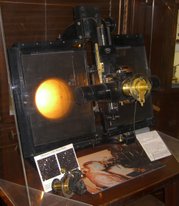Blink comparator
- Blink comparator
-
Comparateur à clignotement
Un comparateur à clignotement est un dispositif opto-mécanique autrefois utilisé par les astronomes pour faire apparaître les différences entre deux photographies de la même portion de ciel prises à des instants différents. Il fonctionne en faisant alterner rapidement les deux images (le « clignotement ») à partir de leur négatif[1].
Il permet d'identifier rapidement les objets changeant de position (planètes, astéroïdes, comètes, composantes de binaires visuelles étoiles à grand mouvement propre) ou de magnitude (étoiles variables, novae).
La planète naine Pluton fut découverte grâce à un comparateur à clignotement de l'Observatoire Lowell (voir image ci-contre)[2].
Bibliographie
- (en) J. P. Tafforin, « Plate comparators » dans Patrick Martinez et Storm Dunlop (dir.), The Observer's Guide to Astronomy, Cambridge University Press, 1994 (ISBN 0521379458)
Sources
Notes et références
- ↑ (en) P. Clay Sherrod, Thomas L. Koed, A Complete Manual of Amateur Astronomy: Tools and Techniques for, Courier Dover Publications, 2003 (ISBN 0486428206)
- ↑ (en) Gerald North, Astronomy in Depth, Springer, 2003 (ISBN 1852335807)
 Portail de l’astronomie
Portail de l’astronomie
Catégories : Instrument astronomique | Instrument optique
Wikimedia Foundation.
2010.
Contenu soumis à la licence CC-BY-SA. Source : Article Blink comparator de Wikipédia en français (auteurs)
Regardez d'autres dictionnaires:
Blink comparator — A blink comparator was a viewing apparatus used by astronomers to find differences between two photographs of the night sky shot using optical telescopes such as astrographs. It permitted rapidly switching from viewing one photograph to viewing… … Wikipedia
blink comparator — an optical instrument used to detect small differences in two photographs of the same field or object by viewing them alternately, switching rapidly from one to the other. [1925 30] * * * … Universalium
blink comparator — noun : an optical instrument by means of which two pictures identical in all but a few details may be registered in a single visual field and viewed alternately in rapid succession * * * an optical instrument used to detect small differences in… … Useful english dictionary
comparator — /keuhm par euh teuhr, kom peuh ray /, n. 1. any of various instruments for making comparisons, as of lengths or distances, tints of colors, etc. 2. Electronics. a circuit for comparing two signals, as readings of duplicate information stored in a … Universalium
blink microscope — noun : a blink comparator in which the compared images are magnified * * * blink microscope, an instrument through which two photographs may be viewed in rapid alternation to check the alteration in position or movement of a star, comet, or other … Useful english dictionary
Clyde Tombaugh — Clyde William Tombaugh Tombaugh at the Lowell Observatory Born February 4, 1906(1906 02 04) in a ranch near Streator, Illinois, U.S. Died January 17, 1997(1997 0 … Wikipedia
Kuiper belt — Known objects in the Kuiper belt, derived from data from the Minor Planet Center. Obje … Wikipedia
Hinman Collator — The Hinman Collator, an early optical collator, was an opto mechanical device for comparing pairs of documents for differences in the text. Documents that appeared similar were said to “collate”. The collator resulted in rapid advances in the… … Wikipedia
Observational astronomy — Mayall telescope at Kitt Peak National Observatory Observational astronomy is a division of the astronomical science that is concerned with getting data, in contrast with theoretical astrophysics which is mainly concerned with finding out the… … Wikipedia
Planets beyond Neptune — Planet X redirects here. For the Planet X doomsday scenario, see Nibiru collision. For other uses, see Planet X (disambiguation). Trans Neptunian planets redirects here. For dwarf planets and small bodies discovered beyond Neptune, see Trans… … Wikipedia

